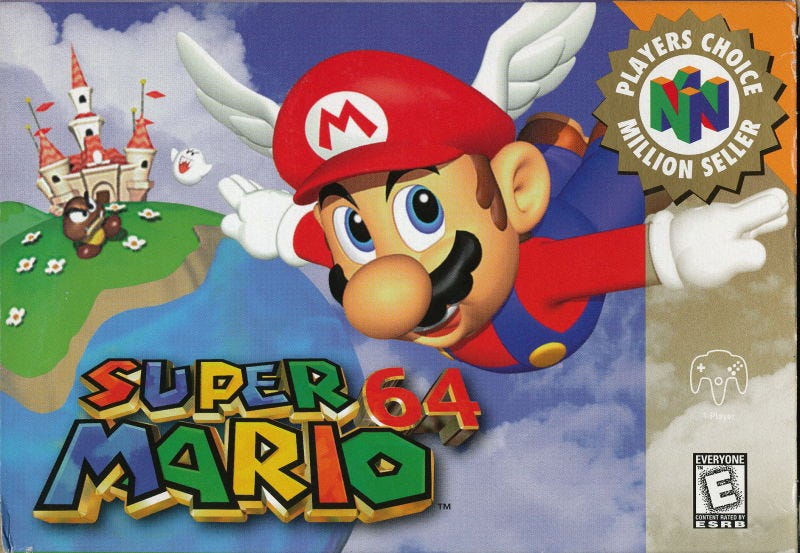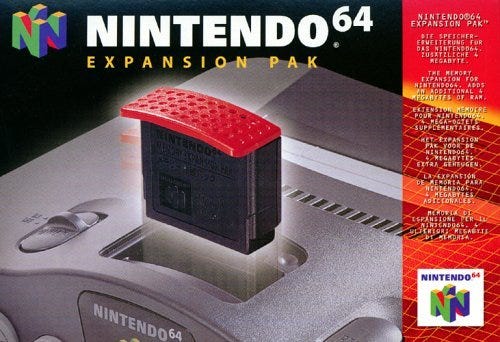25 years of the Nintendo 64
Nintendo's first attempt to rival Sony's Playstation did not always succeed, but the cartridge-based console left behind more than its share of legacy.
On September 29, 2021, the Nintendo 64 will turn 25 years old in North America. Throughout the month of September, I’ll be covering the console, its games, its innovations, and its legacy. Previous entries in this series can be found through this link.
Can you believe that the Nintendo 64 arrived in North America 25 years ago? It’s kind of wild to consider, in retrospect, how significant its legacy is, since Nintendo and the 64 were absolutely trounced by Sony’s arrival into the console market, courtesy the original Playstation: the N64 sold a modest 32 million units worldwide, while Sony’s inaugural effort crossed the 100 million threshold. Now, the N64’s sales — less than one-third what the Playstation managed — are still pretty good when you consider that the third entry on the market, the Sega Saturn, didn’t even sell 10 million consoles, and that the N64 sold around as many total consoles as the GameCube and Wii U managed together, but still. The gap between what the Playstation managed and what the N64 did, sales-wise, is tremendous.
And yet, the legacy of the N64 remains significant. Sticking with a cartridge-based console proved costly for Nintendo, both figuratively and literally, but there is no denying what was achieved on the system even with self-inflicted hurdles like that one in place. Some of what were — and in some cases, still are — the greatest games of all-time arrived on the N64. Nintendo might have lost fans of Japanese role-playing games to Sony, but they made up for that to a degree by taking multiple other genres to the next level, while turning the N64 into the console of the day for shooters, for racing games, for 3D platformers. Second-party developer Rareware was given a basically impossible task, to do the work of multiple studios in order to stuff the N64 library full of must-own exclusives, and they pulled it off. Squaresoft might have left for the Playstation, but plenty of other third-party developers stepped in or stuck with Nintendo, hoping that their games would attract attention on a platform with fewer alternatives.
And, of course, there are the innovations (or improvements to preexisting tech) of the Nintendo 64 that became the norm across the entire industry: the Rumble Pak, native four-player functionality, the use of a thumbstick for analog control, and a very, very proto version of dual-stick functionality thanks to the placement and usage of the controller’s directionally based C buttons — there will be a feature here devoted entirely to the N64 controller, believe me. Maybe all of your friends bought a Playstation, but both hardware and software developers were paying attention to what Nintendo was doing with the N64, and learned from it.

One of the comparatively unsung innovations of the Nintendo 64, though, was finding a way to deliver additional horsepower to the system without creating an expensive add-on. Prior to the N64, consoles would often receive some kind of CD add-on. The Sega Genesis received the Sega CD, which allowed for some improved graphics and sound. The Turbografx-16 received the Turbografx-CD, which did the same and helped to bring the earliest 16-bit console more in line with its competition on that front, at least from a technological standpoint. These were not cheap additions, not even when bundled together with the standard console, and they served to split the userbase, too. Devoted Sega Genesis fans without a Sega CD add-on couldn’t play Sonic CD, for instance, nor could they play Lunar: The Silver Star or its sequel, and so on, and since that add-on initially retailed at $299… well, you get the idea.
Nintendo wasn’t averse to their own add-ons, of course, and even developed one, the 64 Disk Drive, for the N64 that only released in Japan and saw just nine games developed for it. However, the memory Expansion Pak was the true great add-on, and one that cost just $30: it was even bundled with some games, like Donkey Kong 64, which required the Expansion Pak in order to function. The Expansion Pak increased the amount of RAM by 4 MB — hey, this was the 90s, that was a lot — bringing the N64’s total RAM to 8 MB. It was initially supposed to just be part of the 64DD package, but Factor 5, developer of Star Wars: Rogue Squadron, convinced Nintendo to release it as a standalone accessory, which would in turn convince more developers to utilize it in order to work with the additional RAM.
The Expansion Pak wasn’t always necessary in games that used it, but if you had one, the benefits were obvious. For something like Perfect Dark, 65 percent of the game was simply locked away if you didn’t have the Expansion Pak, and the box warned you of as much. The Legend of Zelda: Majora’s Mask required the Expansion Pak to play at all, just like Donkey Kong 64. But most games, like the aforementioned Rogue Squadron, simply used it to improve the experience of a game you could play without the Expansion Pak. The Expansion Pak enabled high-resolution modes in a number of games, to improve frame rate and decrease slowdown, or even in some cases to allow for more than just two players, as the N64’s memory could only handle two otherwise for those particular titles. If you had an Expansion Pak, your memory of what Nintendo 64 games looked like will vary significantly from someone who did not have the upgrade. Some titles with the Expansion Pak’s high-res upgrades look shockingly excellent to this day — obviously, rough around the edges and with less detail than HD-era gamers are used to, but far better than your memory might have allowed you to believe.
Around 60 games utilized the Expansion Pak, and just two of those outright required it: that’s a better batting average than some of those add-ons that cost as much as the console itself, that’s for sure, and is also a space we haven’t seen utilized sense.
The days of CD add-ons are gone, of course, since CDs became the norm and then were replaced by DVDs and blu-rays, but now we get mid-life-cycle refreshes for consoles instead of expansions, refreshes that streamline and shrink the consoles themselves, while adding some additional power to them, and for the same hefty price as the original consoles which, by that point, had likely seen some price drops. Personally I would like to go back to the Expansion Pak era, brief as it was, and there was probably a point in time where Sega wished they had come up with the idea first before splitting their userbase in a zillion directions and causing it to lose faith in them.
The games, though. The games are what people remember the most about the Nintendo 64. The absence of them is one way to remember the games: there were just 393 of them, worldwide, released for the Nintendo 64, significantly fewer than the Playstation (1,100) and even the Saturn (600 of them, though, certainly not all of those Saturn titles released in North America). It was also far fewer than released for the N64’s predecessor, the Super Nintendo, which will happen when your competitor’s console costs a whole lot less to develop for thanks to the format. What the N64 lacked in quantity, though, it often made up for in quality: the N64 had an extraordinary batting average, to the point that Retro Sanctuary created a top 100 list for its games, and managed to come away with one absolutely stuffed with things that are still fun to play today. Consider: a list of 100 N64 games is a list with more than one-quarter of the entire N64 library on it. That’s absurd, and yet, that’s how it went. I can vouch for a significant percentage of that list, too, as my own N64 library, between actual cartridges and Virtual Console purchases, numbers in the mid-60s, and there are at least a few more I’d love to get my hands on again.

I’m devoting most of this next month to covering games that released for the 64 — both through larger features encompassing a number of games each, and in individual spotlight features — and that will all happen without any double-dipping from the significant project that kicked off Retro XP: the Nintendo top 101. I’m confident that there is still plenty to talk about as far as N64 games go, even if I’m telling you now that, if you want to read about Ocarina of Time or Super Mario 64 or any other massively important and quality Nintendo-published N64 game, you just have to check the archives.
I’m not a monster, though: I’ll setup a shortcut for you here! Super Mario 64, of course, changed the way platforming was thought of, and gave the transition to 3D platforming the momentum it needed to become a genre unto itself. The Legend of Zelda: Ocarina of Time, was an even more monumental achievement in my opinion, doing for Zelda what Super Mario 64 did for Mario… and it was upstaged by its sequel, Majora’s Mask.
Arcade-style shooters and shoot-em-ups were in short supply on the N64, thanks to the Saturn successfully cornering at least one other market besides “games published by Sega,” but the Nintendo 64’s attempts at filling that hole were tremendous. Sin & Punishment, a game co-developed by Treasure and Nintendo itself, would have easily been the jewel of the bunch if not for the existence of Star Fox 64. (Now, if only North American N64 owners had also received a release of Treasure’s Bangai-O, too. At least we got Mischief Makers.) Rogue Squadron was a killer console exclusive, as well, and Pokémon Snap was an on-rails “shooter” well ahead of its time, one where exploration and experimentation were center stage instead of just violence.
Role-playing games were in short supply on the N64, but Paper Mario stood out, and continues to stand out to this day as one of the top entries in the series it launched. On the more serious side of the genre, Nintendo published Ogre Battle 64 in Japan, and let Atlus handle localization duties in North America.

Let’s not forget that the N64 was the origin system for the Super Smash Bros. series, too, or that, reticent as I am to compliment Mario Kart 64 when other Mario Karts exist, Mario Kart 64 helped to revolutionize local multiplayer by taking advantage of the system’s four-player functionality. And really, racing in general was fantastic on the N64, whether those releases came through Nintendo or a third-party: more on that particular note is to come.
These are, of course, just the games that have already been written about here, in the roughly year or so that it has existed. You’ll want to keep an eye on your inbox or on this space throughout September if you want to read about additional N64 games. I’ve got plenty to say on those, but will also spend time just looking back at certain elements of the N64 with more detail than can be mustered for an introductory overview post like this one, and I hope that it’s a fun look back at a specific point in video games history that can be enjoyed even if you were more of a Playstation person 25 years ago.
This newsletter is free for anyone to read, but if you’d like to support my ability to continue writing, you can become a Patreon supporter.




